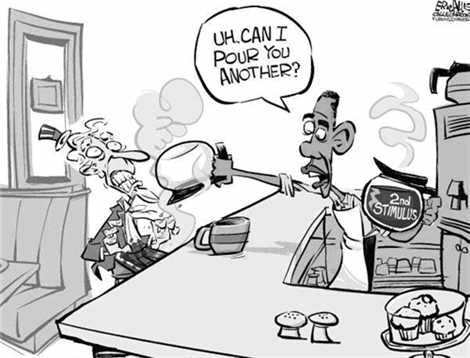How Green Was My Stock Market Rally?
Stock-Markets / Financial Markets 2009 Jul 08, 2009 - 05:16 AM GMTBy: PaddyPowerTrader
 The second big selloff in three days signals the reflation trade is dead and volatility is back with a bang (the VIX was up 6.5% yesterday) as reality intruded on the over-hyped green shoots guff. The Nasdaq was the big loser for the day, falling 2.3%, but it remains the only major US index still in the black for the year. Commodities and crude continue to be unloved and now the markets are fretting that the economy may need a fresh stimulus package. Such talk is killing confidence. With the S&P 500 now trading below its 200 day moving average, stocks may well trade heavy with selling on upticks.
The second big selloff in three days signals the reflation trade is dead and volatility is back with a bang (the VIX was up 6.5% yesterday) as reality intruded on the over-hyped green shoots guff. The Nasdaq was the big loser for the day, falling 2.3%, but it remains the only major US index still in the black for the year. Commodities and crude continue to be unloved and now the markets are fretting that the economy may need a fresh stimulus package. Such talk is killing confidence. With the S&P 500 now trading below its 200 day moving average, stocks may well trade heavy with selling on upticks.
Alcoa earnings report will grab the headlines today but in the overall scheme of things they’re meaningless. We will need to get at least two weeks into the pesky earnings season before passing judgement. For the record, Alcoa’s stock was up 6.1% at one point yesterday after CEO Klaus Kleinfeld said that he was “very optimistic” about sales as the Chinese economy and U.S. automotive industry start to recover.
Today’s Market Moving Stories
- Overnight, Japanese machinery orders for May showed that companies still seem reluctant to invest as orders unexpectedly fell by 3%, which means they have fallen in ten of the past twelve months.
- The US Mortgage Bankers Association reported that credit card delinquencies rose to a record 3.23% in the first quarter, another sign that economic revival has not yet arrived. The US ABC consumer comfort slipped 2 points to -52, 2 points above its January all-time low. In the UK, Nationwide’s consumer confidence improved 5 points to an 8 month high of 58. The consensus was for a read of 55.
- There are talks of a second stimulus package in the US. When the Obama administration proposed a nearly $1 trillion fiscal stimulus package at the start of the year, few imagined that just six months later we would be talking about a second one. The speculation appears to have been triggered by last Friday’s employment report, or specifically the unemployment rate hitting 9.5%, a much higher figure than what was then projected by the administration. They have opened the door to criticism from the right, and to calls for more stimulus from the left. The bigger concern, of course, is financing.
- India, the world’s largest consumer of gold bullion, has doubled import taxes on gold and silver. Record local gold prices in Q1 and the impact of the global recession caused gold imports to slump by 57% in H1 as jewellery demand evaporated and scrap supply surged. Increasing the import tax should further depress jewellery demand, having a greater impact on gold than silver. The tax may also encourage smuggling into India, making this relatively opaque market even less transparent.
- In his FT Deutschland column Wolfgang Munchau said a credit crunch was clearly not yet visible in the German official data, but one should be very careful, since the danger lurks in the next few months. He says it is no surprise that politicians are panicking, given that they might be facing an agonisingly long two-and-a-half credit-crunched months until the general election. He says there is much anecdotal evidence that credit conditions had deteriorated, but he dismisses plans by the government and the Bundesbank for circumventing banks as unrealistic, given that the German economy is structurally dependent.
- Davy’s Stockbrokers have issued a detailed upbeat report on the current state of play with regards to Ireland’s finances and the prospects for NAMA. My key take from it is that the Irish state has already met 85% of its long-term debt issuance targeted for 2009. That compares with a euro area average of about 60% year-to-date. General government debt will of course spike when NAMA is set up, but that will no longer be a meaningful metric. NAMA will contain billions in written-down assets to offset against the government paper issued to the banks. Net debt will rise only to the extent that NAMA fails to realise value over time.
- The Irish Times heralds the return of overseas interest to the Irish property market, stating that a German bank looks set to complete the purchase of the Tommy Hilfiger store in Dublin’s Grafton Street. According to DTZ Sherry Fitzgerald, any investor interest is in high street retail with long leases and a secure income. The bank is expected to pay in the region of €23m for the property, an investment which will show a return of around 6.7%. When the property was first offered for sale, it apparently had a price tag of about €30m.
- Yesterday we noted how keen Deutsche Bank was keep tabs on board members and major shareholders, well Toyota have gone one step further with their employees stealing from and watching porn in a customer’s truck.
- Well if you get a buck fifty sentence the least you can do is get a good prison. Bernie Madoff has hired a top prison consultant to help him find the best possible joint in which to spend the rest of his life.
- We love a good list on a hump day – 12 of the worst financial gurus.

Submerging Markets?
The run-up in asset prices since markets turned at the end of February has not just priced out risk and uncertainty, it has also priced in a view that ‘green shoots’ will turn into a sustainable recovery – and relatively quickly. The alternative case to this recovery being sustainable is that an inventory and policy stimulus-led bounce flounders as credit continues to be rationed and consumers save not spend. It is difficult to escape the conclusion that the hard data remains mixed, with signals unclear and directionless, not yet validating the good news already priced into assets.
I see three specific risks to the fledgling recovery and the longevity of ‘green shoots’ in Emerging Markets: a weak and protracted ‘recovery’ in activity in G3 constrained by rising household savings; a sharp retracement in commodities prices if expectations of Chinese demand are reappraised; and rising concern about fiscal sustainability. Markets that are relatively self sufficient, where trade is a small proportion of overall activity and where financial intermediation is weak, will tend to be least affected by dislocations in global demand and credit availability. In addition, the lower the level of existing public sector debt, the greater will be the scope to finance fiscal programmes to offset the effects of weak external demand.
While the hard data supporting this recovery is still far from convincing, for now downside is limited by plentiful liquidity. As savings rates rise in much of the developed world, so QE is washing through the real economy and feeding into financial assets and tradable commodity prices. As this new bubble inflated, it sucked in investors that had been watching from the sidelines. To be sustainable, asset valuations will need to be supported by economic growth – not just monetary emission. In the near term, this will largely depend on the household savings-consumption decision in markets like the US; and in the longer term on a shift in global consumption patterns.
Equities
- Tullow Oil released a trading statement and operational update this morning which was inline with expectations. The full year 2009 capital expenditure costs estimates have been increased to £700m from the previously expected £600m. This is due to additional exploration and appraisal activities in Ghana and Uganda together with licence acquisitions in the Liberian Basin and exploration drilling in Côte d’Ivoire. The stock is soft this morning but this may have more to do with the fall in oil prices that anything therein.
- More generally, we will see the usual knee jerk weakness in miners and oil producers today on the continuing fall in commodity prices as the bets on the reflation trade are unwound painfully.
- Infineon may trade to the upside after it agreed to offload its Wireline Communications business for €250 million.
- Echoing the downbeat numbers from CRH yesterday, cement giant Holcim said that it expects a “difficult” 2009. Its shares were down 2% at the off. It is looking to raise $1.9bn in a rights issue to finance an acquisition in Australia.
Data Today
There are two highlights on the slate today, which these thin markets might make a meal of. First up is Eurozone GDP at 10:00. Normally we would not expect anything special from a final GDP reading, but last week’s UK final Q1 GDP release was further out of kilter than one would normally expect, so the market is likely to be on its toes for a revision to this number.
Later on at 11:00, following yesterday’s factory orders data, expectations for German industrial production are likely to be above those given by the consensus figure on the screens.
And Finally… A Novel Approach To Balancing The Books In California
Disclosures = None
By The Mole
PaddyPowerTrader.com
The Mole is a man in the know. I don’t trade for a living, but instead work for a well-known Irish institution, heading a desk that regularly trades over €100 million a day. I aim to provide top quality, up-to-date and relevant market news and data, so that traders can make more informed decisions”.
© 2009 Copyright PaddyPowerTrader - All Rights Reserved
Disclaimer: The above is a matter of opinion provided for general information purposes only and is not intended as investment advice. Information and analysis above are derived from sources and utilising methods believed to be reliable, but we cannot accept responsibility for any losses you may incur as a result of this analysis. Individuals should consult with their personal financial advisors.
PaddyPowerTrader Archive |
© 2005-2022 http://www.MarketOracle.co.uk - The Market Oracle is a FREE Daily Financial Markets Analysis & Forecasting online publication.




